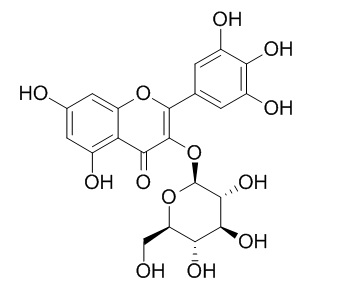Myricetin 3-O-beta-D-glucopyranoside
Myricetin 3-O-beta-D-glucopyranoside may have antioxidant, and anti-inflammatory activities.
Inquire / Order:
manager@chemfaces.com
Technical Inquiries:
service@chemfaces.com
Tel:
+86-27-84237783
Fax:
+86-27-84254680
Address:
1 Building, No. 83, CheCheng Rd., Wuhan Economic and Technological Development Zone, Wuhan, Hubei 430056, PRC
Providing storage is as stated on the product vial and the vial is kept tightly sealed, the product can be stored for up to
24 months(2-8C).
Wherever possible, you should prepare and use solutions on the same day. However, if you need to make up stock solutions in advance, we recommend that you store the solution as aliquots in tightly sealed vials at -20C. Generally, these will be useable for up to two weeks. Before use, and prior to opening the vial we recommend that you allow your product to equilibrate to room temperature for at least 1 hour.
Need more advice on solubility, usage and handling? Please email to: service@chemfaces.com
The packaging of the product may have turned upside down during transportation, resulting in the natural compounds adhering to the neck or cap of the vial. take the vial out of its packaging and gently shake to let the compounds fall to the bottom of the vial. for liquid products, centrifuge at 200-500 RPM to gather the liquid at the bottom of the vial. try to avoid loss or contamination during handling.
Nutrients.2021, 13(12):4364.
Food Chem.2024, 456:140044.
Natural Product Communications2020, doi: 10.1177.
Cardiovasc Toxicol.2021, 21(11):947-963.
Int J Mol Sci.2022, 23(1):538.
J Enzyme Inhib Med Chem.2019, 34(1):134-143
Turk J Med Sci.2023 53: 1312-1320.
Molecules.2022, 27(7):2093.
Metabolites2022, 12(6),507.
Phytother Res.2019, 33(3):676-689
Related and Featured Products
Evid Based Complement Alternat Med. 2014;2014:283938.
Antioxidant activities and phytochemicals of leaf extracts from 10 native rhododendron species in taiwan.[Pubmed:
24987425 ]
Rhododendron, one of the most famous ornamental plants in the world, is traditionally a medicinal plant. However, the potential bioactivities of native Rhododendron in Taiwan have not been completely studied.
METHODS AND RESULTS:
In this study, the results revealed that Rhododendron pseudochrysanthum exhibited the best antioxidant activities among 10 native Rhododendron species in Taiwan. Furthermore, based on a bioactivity-guided isolation principle, nine specific phytochemicals were isolated and identified as (2R,3S)-catechin (1), (2R,3R)-epicatechin (1'), (2R,3R)-dihydromyricetin 3-O- β -l-arabinopyranoside (2), (2S,3S)-taxifolin 3-O- β -l-arabinopyranoside (2'), (2R,3R)-taxifolin 3-O- β -l-arabinopyranoside (3), Myricetin 3-O-beta-D-glucopyranoside(3'), rutin (4), hyperoside (5), and quercitrin (6). Of these compounds, 2 and 3 were found to be major bioactive compounds, and their concentrations in the n-butanol (BuOH) fraction were determined to be 52.0 and 67.3 mg per gram, respectively.
CONCLUSIONS:
These results demonstrated that methanolic extracts of Rhododendron pseudochrysanthum leaves have excellent antioxidant activities and great potential as a source for natural health products.
J Pharm Pharmacol. 2006 Jul;58(7):981-8.
An extract of Lannea microcarpa: composition, activity and evaluation of cutaneous irritation in cell cultures and reconstituted human epidermis.[Pubmed:
16805959]
Lannea microcarpa (Anacardiaceae) is a tropical tree used in African folk medicine and commercial dermopharmaceutical formulations.
METHODS AND RESULTS:
Fractionation and analysis of its polar extract allowed the identification of 4'-methoxy-myricetin 3-O-alpha-L-rhamnopyranoside, myricetin 3-O-alpha-L-rhamnopyranoside, Myricetin 3-O-beta-D-glucopyranoside, vitexin, isovitexin, gallic acid and epi-catechin, as the major constituents. In-vivo assay (the croton oil ear test in mice) showed that the extract had significant anti-inflammatory effect (ID50 = 900 microg cm(-2)) but ten times lower than that of indometacin (ID50 = 93 microg cm(-2)), the non-steroidal anti-inflammatory drug used as reference. Cytotoxicity and cutaneous irritation of the extract and its constituents were investigated.
CONCLUSIONS:
The crude extract and its major components did not affect cell viability in-vitro either in three different cultures (J774. A1, WEHI-164 and HEK-293) of cells grown in monolayers or in the reconstituted human epidermis (RHE, 3D model), nor did they cause release of pro-inflammatory mediators (IL-1alpha) or histomorphological modification of RHE.



